Release 1.0.2 for Sun SPARC Solaris
Part Number A86239-01
Library |
Contents |
Index |
| Oracle9i Application Server Installation Guide Release 1.0.2 for Sun SPARC Solaris Part Number A86239-01 |
|
This chapter guides you through the installation steps for the Standard Edition of Oracle9i Application Server. It lists basic steps for a quick installation and provides detailed information for reference. This is followed by basic post-installation tasks.
The following instructions guide you through the Standard Edition installation option of Oracle9i Application Server.
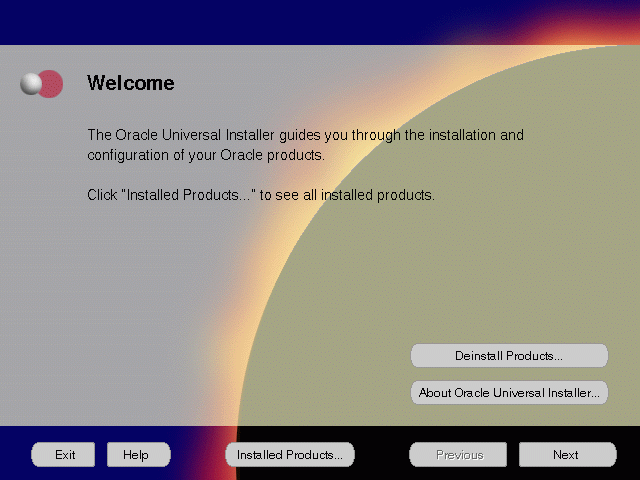
The Welcome screen provides information about the Oracle Universal Installer.
The following function buttons appear on the installation screens.
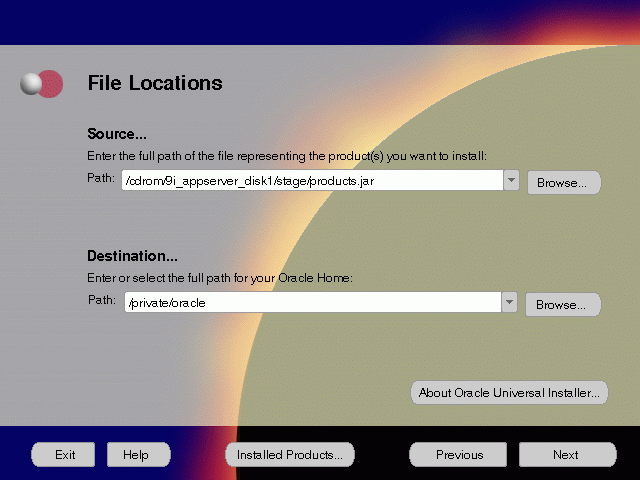
The File Locations screen allows you to enter the full path for the source and destination locations of Oracle9i Application Server.
For more information regarding ORACLE_HOME, refer to "ORACLE_HOME".
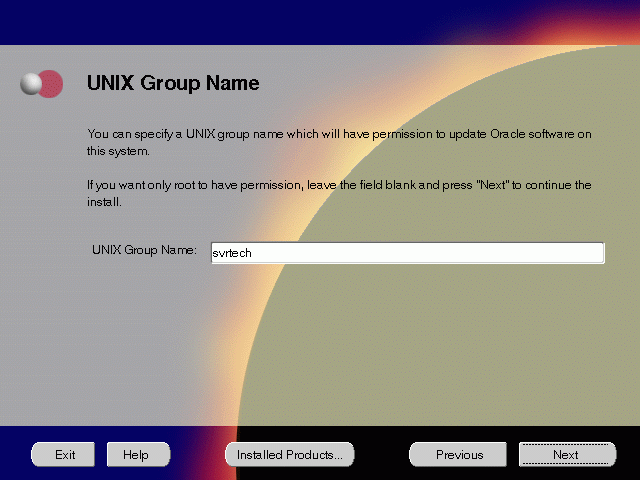
The UNIX Group Name screen grants permission for the oraInventory directory to the group specified. For more information, refer to "UNIX Group Name for the Oracle Universal Installer Inventory" on page 2-9.
UNIX Group Name:
prompt> id
After you have run the script, click Retry to continue.

The Installation Types screen allows you to select the Oracle9i Application Server installation option that you are licensed to use. For a complete list of components installed through each installation option, refer to Table 2-1, "Oracle9i Application Server Components" .
The following are the installation options:
This screen appears only under the following condition(s):
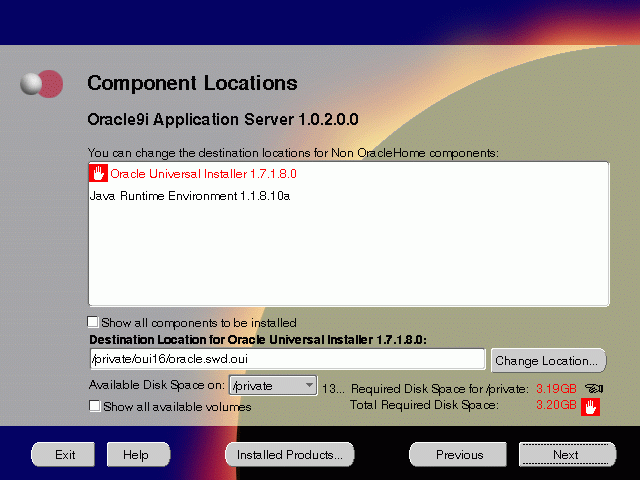
The Component Locations screen allows you to select alternative locations for some components.
Click individual components to view and change destination location path. The installer enables you to change the destination location of the components displayed on the screen.
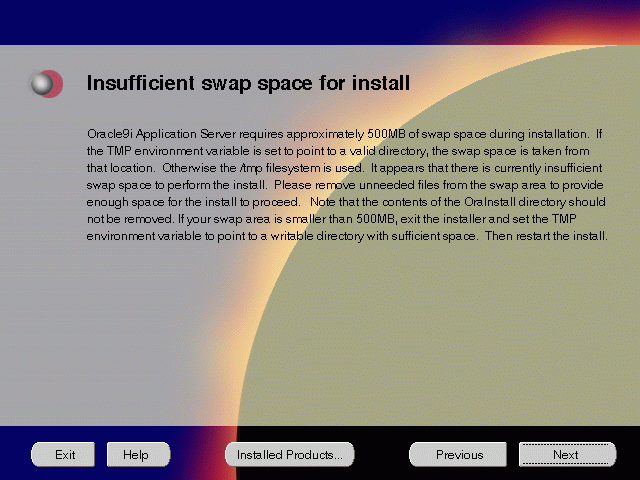
Insufficient Swap Space for Install screen indicated inadequate space in the swap directory. You have two options:
For detailed information on TMP directory, refer "TMP".
oracle account is not a member of the dba group.

The Privileged Operating System Groups screen allows you to enter the database administrator and operator group name. For more information regarding privileged group names, refer to "UNIX Group Names for Privileged Groups". The installer detects and defaults to the user's OS group.
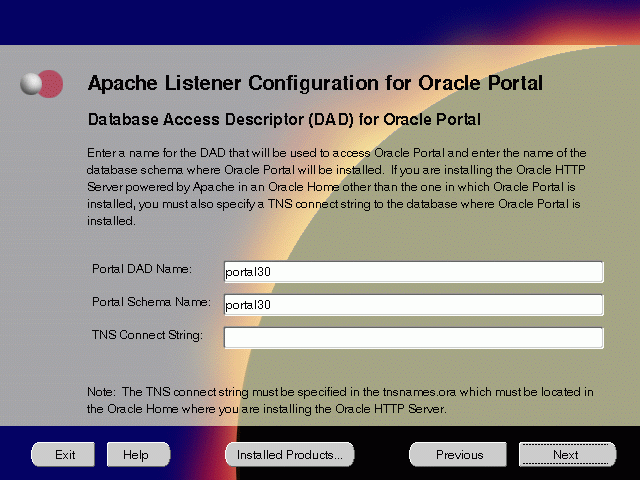
The Apache Listener Configuration for Oracle Portal DAD screen allows you to enter the name of the Database Access Descriptor (DAD) that will be used to access Oracle Portal, and the name of the database schema where Oracle Portal will be installed. It also enables you to enter the TNS connect string if Oracle Portal and Oracle HTTP Server are installed in different Oracle homes. The information you enter here is used to create the PL/SQL Gateway settings which you can access upon installation from the following location: http://<machine_name>:<port>/pls/admin_/gateway.htm
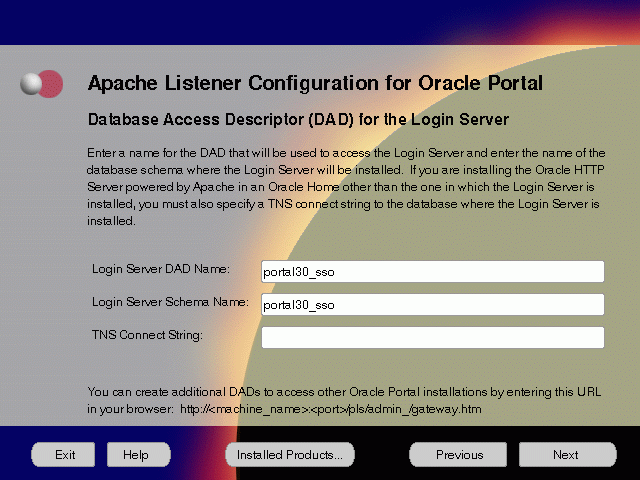
The Apache Listener Configuration for Oracle Portal screen allows you to enter the Login Server DAD and Schema Name, with a _sso extension for easy recognition. The Login Server provides an enterprise-wide Single Sign-On (SSO) mechanism that enables an Oracle Portal user to log in securely to Oracle Portal and any partner and external applications using a single user name and password. It also enables you to enter the TNS Connect String if Oracle Portal and Oracle HTTP Server are installed in different Oracle homes.
For more information on these fields, refer to the previous screen.

The Database Identification screen allows you to enter the Global Database name and SID of the database.
db.us.oracle.com
Where db is the name of the database and us.oracle.com is the network domain in which the database is located.
db). You can accept or change the default value.

The Database File Location screen allows you to enter the directory name for the database files. Oracle recommends installing the database software and the database content, including files, on separate disks.
| File Type | Path Name |
|---|---|
|
Data Files |
/dbmount/oradata/SID/*.dbf |
|
Control Files |
/dbmount/oradata/SID/*.ctl |
|
Log Files |
/dbmount/oradata/SID/*.log |
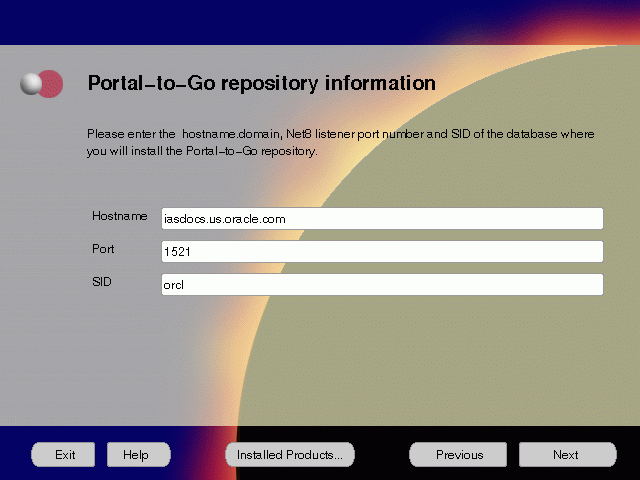
The Portal-to-Go Repository Information screen allows you to enter the hostname, Net8 Listener port number, and SID of the database where you will install the Portal-to-Go repository.

Portal-to-Go Schema Information screen allows you to create a database user to store the Portal-to-Go repository.
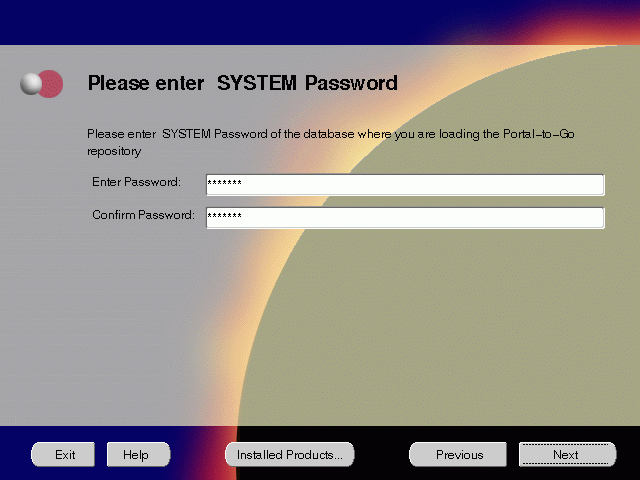
System Password screen allows you to enter and confirm the SYSTEM password of the database where you are loading the Portal-to-Go repository.

The Summary screen allows you to review all the settings before the actual installation process. These settings include source, destination, installation type, product language, space requirements, and a list of components.
When you click Install, the installation process begins.
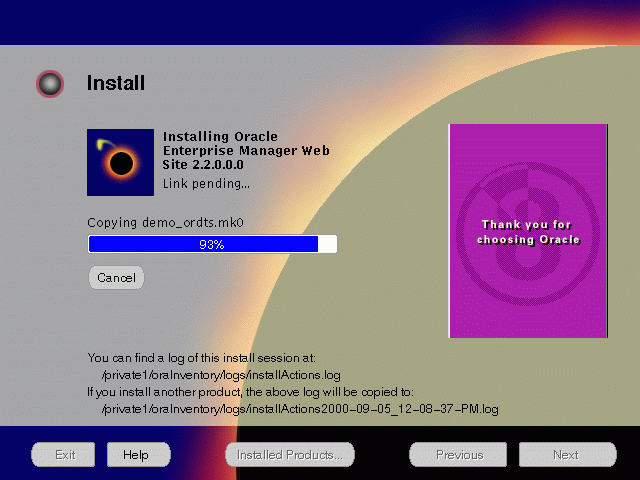
The Install screen appears while the product is installing. Installation operations include executing actions such as file copy and linking, and executing decision points and calculations. It also displays the full path of the installation log.
For more information about installation log, refer to "oraInventory Directory".
Changing Disks
During installation, the installer prompts you to switch between Disks 1, 2 and 3. Use these steps to change disks and continue the installation process.

If you are using Solaris Volume Management software and Disk1 was automatically mounted, then this can be done with the following command:
prompt> eject cdrom
If you are not using Solaris Volume Management software, then you must manually eject and unmount the disk. For further instructions, refer to your operating system documentation
If you are using the Solaris Volume Management software, then the next disk will be automatically mounted.
If you are not using Solaris Volume Management software, then you must manually mount the disk. For further instructions, refer to "Starting Oracle Universal Installer".

Running root.sh
After installation is completed, the installer prompts you to run root.sh script. Use these steps to run the root.sh script.
prompt> cd $ORACLE_HOME
prompt> ./root.sh
Once you see "Finished running generic part of the root.sh script" and "Now product-specific root actions will be performed," exit root user and return to the Install screen.
The root.sh script detects:

The Configuration Tools screen lists the configuration tools for all installed components.
Scroll down the list to review the configuration status of each tool. The status changes as each component is configured.
The installer performs the following functions in this screen:
Configuration Tools
This installation option launches the following configuration tools:
Net8 Configuration Assistant - It enables you to connect and configure the Oracle client/server network environment.
For more information on Net8 Configuration Assistant, refer to the Net8 Administration's Guide in the Oracle database documentation set.
Oracle Database Configuration Assistant - It configures the database for Oracle8i JVM. For instructions on running the Oracle Database Configuration Assistant, refer to "Oracle Database".
Starting Web Server in Non-SSL mode on port 7777 - This starts Oracle HTTP Server.
Oracle Portal Configuration Assistant - It loads necessary database objects for Oracle Portal to run. For instructions on running the Oracle Portal Configuration Assistant, refer to "Oracle Portal".
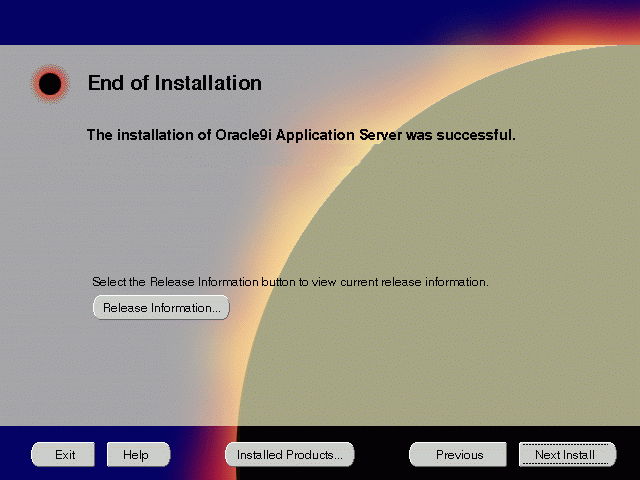
The End of Installation screen appears at the end of the installation process. It notifies you whether the installation was successful or unsuccessful.
You have successfully installed the Standard Edition installation option of the Oracle9i Application Server. Proceed to Post-installation to complete the installation process.
The following instructions guide you through the basic post-installation tasks for Oracle9i Application Server. Before performing these tasks, be sure to install Oracle Portal-to-Go client from the Oracle9i Application Server Administrative and Development Client CD included in the Oracle9i Application Server CD pack. For installation instructions, refer to Appendix B, "Installing Oracle Portal-to-Go Client".
The post-installation contains the following sections:
Table 4-1 lists the environment variables that must be set for Standard Edition installation option:
Table 4-2 lists the commands needed to start and stop the components.
Table 4-3 lists the default port numbers on which requests are received for each component.
This section contains post-installation tasks for the following components:
You must run the Oracle Internet File System configuration assistant to configure Oracle Internet File System. For configuration instruction, refer to "Oracle Internet File System".
The following section describes post-installation configuration instructions for Oracle Portal-to-Go:
Oracle Portal-to-Go Web Integration Server hosts services that applications can use to exchange data and information sources via the Web. The Web Integration Server is installed with the Oracle Portal-to-Go components.
|
Note: The Web Integration Developer, the development environment for creating and testing Web Integration services written in Web Interface Definition Language (WIDL), is installed as part of the Oracle Portal-to-Go client. For more information, refer to Appendix B, "Installing Oracle Portal-to-Go Client". |
The following steps guide you through the configuration process of the Web Integration Server:
From the ORACLE_HOME/panama/WebIntergration/Server/bin directory, type:
prompt> ./server.sh &
http://host_name.domain:5555
The httpd.conf file is in the ORACLE_HOME/Apache/Apache/conf directory.
Create a Personalization Portal (papz) alias. This is needed so that the application server can find the http://hostname/papz/login.jsp URL. Add a line at the end of the Alias section:
# PTG Start Alias /papz/ "<ORACLE_HOME>/panama/server/papz/" # PTG End
The jserv.conf file is in the ORACLE_HOME/Apache/Jserv/etc directory.
In the ApJServMount section, add the Oracle Portal-to-Go specific mount point:
# PTG Start ApJServMount /ptg /root # PTG End
The jserv.properties file is in the ORACLE_HOME/Apache/Jserv/etc directory.
Next to the other "wrapper.classpath" entries, add all the required Oracle Portal-to-Go files to the classpath.
# PTG Start wrapper.classpath=<ORACLE_HOME>/panama/server/classes wrapper.classpath=<ORACLE_HOME>/panama/lib/panama_core.zip wrapper.classpath=<ORACLE_HOME>/panama/lib/panama_papz.zip wrapper.classpath=<ORACLE_HOME>/panama/lib/client.zip wrapper.classpath=<ORACLE_HOME>/panama/lib/server.zip # PTG End
The zone.properties file is in the ORACLE_HOME/Apache/Jserv/etc directory.
# PTG Start repositories=<ORACLE_HOME>/Apache/Jserv/servlets,<ORACLE_ HOME>/panama/server/papz # PTG End
# PTG Start servlets.startup=oracle.panama.ParmImpl # PTG End
# PTG Start servlet.rm.code=oracle.panama.ParmImpl # PTG End
After installation, you can verify that individual Oracle Portal-to-Go components are properly configured:
http://host_name.domain:7777/papz/test.jsp
"Hello World" should appear on the screen.
http://host_name.domain:7777/papz/login.jsp
The login page should appear. The Personalization Portal prompts you to enter a user name and a password. You can log in using "Administrator" as the user name and "manager" as the password.
http://host_name.domain:7777/ptg/rm
For more information regarding the post-installation tasks and configuration, refer to component-specific documentation in "Documentation Library Titles" .
|
|
 Copyright © 2000 Oracle Corporation. All Rights Reserved. |
|